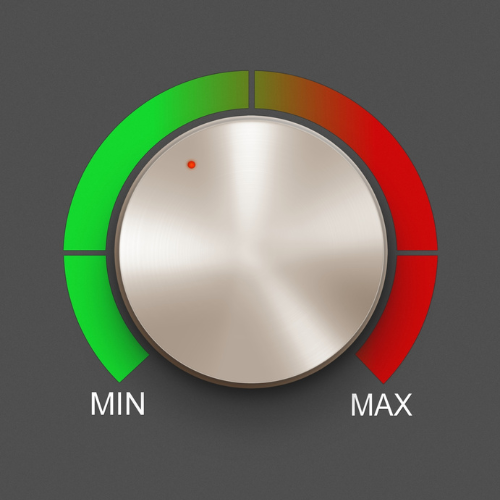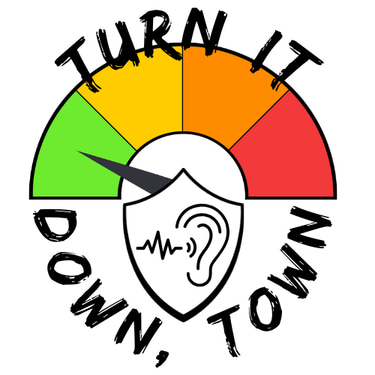The Facts
The Science of Sound: Why Volume Matters
Sound surrounds us—but when it’s too loud, too constant, or poorly managed, it can do more than annoy. It can harm. Let’s explore the science behind noise exposure and its impact on our health, development, and daily functioning. From the delicate ears of children to the sensory sensitivities of neurodivergent individuals, excessive noise can lead to hearing damage, stress, communication barriers, and even long-term cognitive effects.
Whether you're a parent, a business owner, or simply someone who values a more thoughtful public space, understanding the facts is the first step toward meaningful change. Let’s turn down the volume—and turn up the awareness.


db vs. dBC: What Are We Really Measuring?
When you use a decibel meter to measure sound, you might notice two different readings: dB and dBC. Both are important—but they tell slightly different stories. Knowing the difference helps us better understand how sound affects our bodies, our brains, and our environments.
Many sound meters report both values because they capture different aspects of sound intensity and frequency. This matters especially when advocating for safer sound levels in spaces shared by children, neurodivergent individuals, and the general public.
dB (Decibel)
Measures the overall intensity or loudness of sound.
It’s a logarithmic scale, meaning every 10 dB increase represents a tenfold increase in sound energy.
Commonly used to compare sound levels in everyday environments.
dBC (Decibels with C-weighting)
dBC (Decibels with C-weighting):Adjusts the measurement to reflect how humans perceive low-frequency sounds (like bass or rumbling HVAC systems).
Often used in industrial, music, and environmental noise assessments.
Helps identify sounds that may not seem loud but still cause stress or discomfort—especially for those with sensory sensitivities.
Why Both Matter
dB gives a general picture of loudness.
dBC reveals hidden risks from low-frequency noise that can be especially disruptive to babies, neurodivergent individuals, and those with hearing loss.
Using both helps paint a fuller picture of how sound affects people—not just how loud it is.
Why a Few Decibels Make a Big Difference
Decibels (dB) don’t work like regular numbers—they’re measured on a logarithmic scale, which means each increase of 10 dB represents ten times more sound energy. So while going from 60 to 70 dB might seem like a small jump, it’s actually 10 times louder in terms of energy. And 80 dB? That’s 100 times louder than 60 dB. This is why even small increases in volume can feel dramatically more intense—especially for babies, neurodivergent individuals, or anyone sensitive to sound. Understanding this helps explain why turning down the volume just a little can make a big difference in comfort and safety.
Decibel Levels, Common Sources, and Health Impact
30–40 dB
Library, quiet home
Ideal for focus and rest
50–60 dB
Conversation, moderate traffic
Can cause stress in sensitive individuals
70–85 dB
Restaurant, vacuum cleaner
Prolonged exposure may lead to hearing fatigue
85–100 dB
Lawn mower, live music
Risk of hearing damage after 1–2 hours
100+ dB
Concerts, sirens
Immediate risk of hearing loss; physical discomfort common
Scientific Findings
The World Health Organization recommends keeping environmental noise below 55 dB during the day and 40 dB at night to protect public health.
Studies show that chronic exposure to noise above 70 dB can increase risks of hypertension, sleep disruption, and cognitive impairment.
Children and older adults are especially vulnerable to noise-related stress and hearing damage.
How Sound Affects the Body and Brain
State and Local Noise Ordinances: What’s “Normal”?
While the Noise Control Act of 1972 laid the groundwork for federal noise regulation, enforcement was largely handed off to state and local governments in the 1980s. That means most noise rules today are created and enforced at the city or county level, with wide variation in how sound is measured, what’s considered “too loud,” and when enforcement kicks in.
Residential Zones
Daytime Limit (7am–10pm): 55–65 dBA
Nighttime Limit (10pm–7am): 45–55 dBA
Notes: Lower limits at night to protect sleep
Commercial Zones
Daytime Limit: 60–70 dBA
Nighttime Limit: 50–60 dBA
Notes: Often allows more ambient noise
Industrial Zones
Daytime Limit: 70–80 dBA
Nighttime Limit: 60–70 dBA
Notes: Higher thresholds due to machinery
Plainly Audible Standards: Many ordinances also include subjective rules like “no sound should be plainly audible 50 feet from the source,” especially for music, parties, or vehicles.
Time-of-Day Restrictions: Leaf blowers, construction, and amplified music often have specific time windows when they’re allowed.
Zoning Matters: What’s acceptable in a commercial zone may be prohibited in a residential one—even if the decibel level is the same.
Typical Local Ordinance Patterns
How Sound Is Measured Locally
Most ordinances use A-weighted decibels (dBA) to mimic human hearing.
Some cities also include C-weighted decibels (dBC) for low-frequency sounds, especially in industrial or music-heavy areas.
Enforcement tools include handheld sound meters, mobile apps, and sometimes permanent monitoring stations.
Why Loud Sounds Are Especially Harmful to Babies and Children
Babies and young children experience the world through sound long before they understand it. Their developing ears and brains are especially vulnerable to loud environments, which can affect not just hearing, but sleep, learning, and emotional well-being. Whether you're a parent, caregiver, business owner, or community advocate, understanding how noise impacts children is the first step toward creating safer, more nurturing spaces. This page explores the science behind sound sensitivity in early childhood—and why turning down the volume can make a world of difference.
Children’s ears are more sensitive than adults’.
Babies and young children have smaller ear canals, which amplify high-frequency sounds more intensely. This makes loud environments even more overwhelming and potentially damaging for them.
Noise exposure can cause permanent hearing loss.
Repeated or sudden exposure to loud sounds—like fireworks, concerts, or noisy toys—can lead to Noise-Induced Hearing Loss (NIHL). This damage is often irreversible, affecting the tiny hair cells in the inner ear that transmit sound to the brain.
Even everyday noise can disrupt development.
Background noise from traffic, TVs, or loud appliances can interfere with sleep, concentration, and language acquisition. During critical developmental windows, this can hinder reading skills, listening comprehension, and emotional regulation.
Sleep machines and toys can be loud.
Infant sleep aids and toys sometimes exceed safe decibel levels. The American Academy of Pediatrics recommends keeping sound machines below 50 dB and placing them at least 7 feet away from the crib.
Turning It Down for Their Future
Every child deserves a calm, welcoming environment where they can grow, learn, and thrive. By reducing unnecessary noise and being mindful of volume levels, we’re not just protecting hearing—we’re supporting healthy development, emotional regulation, and lifelong learning. Whether it’s lowering the music in a café, softening toy sounds, or creating quiet zones in public spaces, small changes add up. Let’s turn it down—for their comfort, their safety, and their future.
Hearing Loss Happens Naturally, But Noise Speeds It Up
Most people begin to lose some hearing as they age. It’s called presbycusis, and it typically affects high-frequency sounds first—like birdsong, soft speech, or consonants like “s” and “f.” But here’s the catch: exposure to loud sounds can dramatically speed up this natural decline, leading to earlier and more severe hearing loss.
Hearing loss often starts subtly.
You might notice you’re turning up the TV, asking people to repeat themselves, or struggling in noisy restaurants. These are early signs of mild hearing loss, which begins around 26–40 dB thresholds.
Loud sounds damage inner ear cells.
Sounds above 85 dB—like lawnmowers, blenders, or busy traffic—can cause permanent damage over time. Concerts, sporting events, and loud workplaces often exceed 100 dB, putting your hearing at serious risk.
The damage is cumulative.
Just like sun exposure adds up over a lifetime, so does noise. The more often you're exposed to high decibel levels, the more likely you are to experience moderate to severe hearing loss earlier than expected.
People in noisy jobs are vulnerable.
Research shows that men are twice as likely to experience hearing loss, and long-term exposure to loud environments—like construction, manufacturing, or music venues—can accelerate decline.
Protecting Our Hearing Is a Lifelong Act of Care
Hearing loss isn’t just a part of aging—it’s something we can influence through everyday choices. By lowering the volume, limiting exposure to loud environments, and advocating for quieter public spaces, we’re not only protecting our own hearing—we’re creating a more inclusive world for everyone. Whether you’re 25 or 75, it’s never too early (or too late) to start caring for your ears. Let’s turn it down together—for clarity, connection, and lifelong sound health.
Sound Sensitivity and the Neurodivergent Experience
For many neurodivergent individuals—including those with autism, ADHD, sensory processing disorder, and other cognitive differences—sound isn’t just background noise. It’s a powerful force that can shape comfort, focus, and emotional well-being. Loud environments, unpredictable sounds, and high decibel levels can trigger sensory overload, making everyday spaces feel chaotic or even painful. Understanding these responses isn’t just about awareness—it’s about creating inclusive, respectful environments where everyone can thrive.
Sensory overload is real—and exhausting.
Neurodivergent brains often process sensory input differently. Loud or layered sounds can overwhelm the nervous system, leading to anxiety, irritability, headaches, and even physical pain. This can result in shutdowns, meltdowns, or withdrawal from social spaces.
Auditory hypersensitivity is common.
Up to 70% of autistic individuals experience decreased sound tolerance. Everyday noises—like hand dryers, sirens, or clinking dishes—can feel physically painful or emotionally distressing, especially when unpredictable or high-pitched.
Noise disrupts focus and communication.
In classrooms, workplaces, and public spaces, background noise can jumble speech, reduce comprehension, and impair memory. Neurodivergent individuals may struggle to filter sounds, making it harder to concentrate or engage socially.
Migraines amplify sound sensitivity.
People with migraines often experience phonophobia—a heightened sensitivity to sound that can make even normal noise levels feel unbearable. Loud environments can trigger or worsen migraine episodes, leading to pain, nausea, and disorientation.
Turning Down the Volume, Turning Up Inclusion
Sound sensitivity isn’t a personal quirk—it’s a neurological reality for millions. By reducing unnecessary noise, offering quiet zones, and designing spaces with acoustic care, we make room for neurodivergent individuals and those with migraine sensitivity to feel safe, focused, and respected. Whether it’s a café, classroom, or community event, turning down the volume is a simple act of inclusion. Let’s build a world that listens better—because everyone deserves to be heard.
Not neurodivergent by definition, but closely related.
Migraines are a neurological condition, not officially classified as neurodivergent. However, they frequently co-occur with neurodivergent traits and diagnoses like autism and ADHD, suggesting shared sensory vulnerabilities.
Similar accommodations apply.
Individuals with migraine-related sound sensitivity benefit from the same environmental supports: quiet zones, volume control, predictable soundscapes, and the ability to step away from overwhelming noise.
We Welcome Your Expertise!
If you're a professional in audiology, occupational therapy, psychology, education—or someone with firsthand experience navigating sound sensitivity or neurodivergence—we’d love to hear from you. Your insights, suggestions, and lived experience can help shape more inclusive, sound-conscious spaces.
Whether it’s a brief statement, a practical tip, or a deeper dive into the science, your voice matters. Submissions may be featured in our marketing materials, website content, or outreach efforts to help raise awareness and foster empathy.
Together, we’re building a community rooted in accessibility, informed care, and real-world wisdom.
Turn it Down, Town
Promoting sound-conscious public spaces for all.
Subscribe!
No noise, just news once a quarter! Get on the list!
© 2025. All rights reserved.
Site Designed by: Budde Designs
